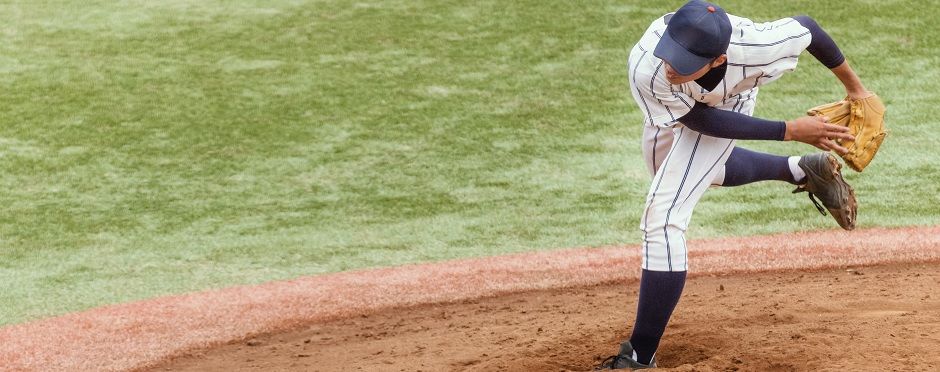
Thrower’s Shoulder: Somewhere Between a Flexible and Stable Place
Leave a CommentThe start of the spring season means that it is finally time for many athletes to implement off-season drills, workouts, and preparation for competition. For baseball players and other throwing athletes, especially pitchers, this means a lot of throwing.
The Anatomy and Mechanisms of the Throwing Motion
The physical act of throwing a baseball is arguably the fastest and most aggressive maneuver the body can endure.1 Throwing requires the marriage of both shoulder flexibility and stability. This relationship between maximal motion and stabilizing strength is referred to as the thrower’s paradox.1 Like all repetitive and forceful activities, there runs a risk of pain and injury. “Pain and dysfunction in the throwing shoulder may be attributed to numerous etiologies, including those of the joint, muscular or neurovascular structures.”1 These physical demands with throwing sports make education on the movement and anatomy paramount in order to best identify, treat, and prevent sidelining-injuries.
Sources of Potential Injury
-
Rotator Cuff
- The rotator cuff is a group of muscles that surround and attach to the bony structures of the shoulder girdle. The purpose of these muscles is to allow for motion and provide the strength needed to stabilize the shoulder joint. However, the repetitive nature of throwing can put heavy loads on the rotator cuff which commonly lead to injuries categorized as impingement, tendinitis, and possible tearing.1 The most common onset of these type of injuries are mechanical failures from fatigue or degenerative changes in the rotator cuff muscles over time. Early signs and symptoms of typical rotator cuff injuries for throwers could include pain with overhead activity or nighttime pain which radiates to the elbow.1
-
The Shoulder Girdle Complex
- Diving deeper (literally) into the anatomy of the shoulder, the capsulolabral complex, or ball and socket with respective ligaments, also works to provide stability. Throwing a ball creates rapid motion about the glenohumeral joint (the ball and socket joint that allows for movement in all planes) paired with compressing and pulling (distracting) forces on its stabilizing structures. These forces on the ball and socket place the capsule’s structures at high risk for mechanical change. Any mechanical changes to the shoulder anatomy due to instability from such repetitive forces can also lead to the impingement of several soft structures (tendons) between hard bony structures (clavicle, acromion).1
-
Scapular Involvement of Shoulder Pain
- For individuals with said impingement symptoms, it is important to continue looking at the kinetic chain like the scapula and its role on function and pain. The scapula, or large bony structure on the upper back, provides a base for all the muscles of the rotator cuff, as well as contributes to upper-arm range of motion. Without this stable base working optimally, there would be a breakdown of energy transfer during the throwing motion most likely resulting in pain or the potential of further injury. Therefore, any structural change to the positioning of the scapula from muscle tightness, capsule tightness and/or muscle weakness could lead to changes in the scapula’s mechanics and manifest as impingement.1
Assessment and Rehabilitation
In summary, large forces placed on the shoulder over time can contribute to instability, weakness, and tightness of soft tissue creating mechanical changes. These performance limitations can have long lasting orthopedic effects on the shoulder mechanics resulting in not only pain but a wide degree of injury that may require medical intervention.
Exercises for combating said limitations include stretching the joint capsule and soft tissue, strengthening the rotator cuff and core muscles, improving muscular endurance, increasing dynamic stability, and improving throwing mechanics. An early diagnostic assessment of shoulder pain can help rehabilitate and prevent further chronic injury.
If you would like to learn more about enhancing your baseball performance and preventing throwing injuries, Athletico offers a video throwing analysis. If you experience any pain or injuries during play, contact Athletico Physical Therapy for a free assessment. Free assessments are available in-clinic or virtually through our Telehealth platform.
The Athletico blog is an educational resource written by Athletico employees. Athletico bloggers are licensed professionals who abide by the code of ethics outlined by their respective professional associations. The content published in blog posts represents the opinion of the individual author based on their expertise and experience. The content provided in this blog is for informational purposes only, does not constitute medical advice and should not be relied on for making personal health decisions.
Reference:
1. Seroyer, S. T., Nho, S.J., Bach, B. R., Bush-Joseph, C. A., Nicholson, G.P., & Romeo, A.A. Shoulder Pain in the Overhead Throwing Athlete. Sports Health, (v.1. p108-120). 2009.
